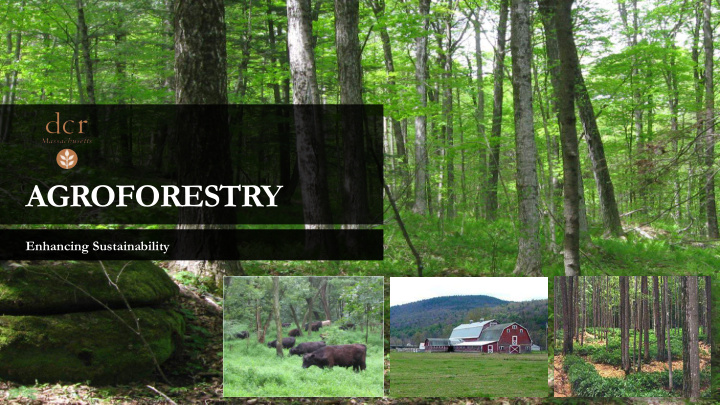



AGROFORESTRY Enhancing Sustainability
What is Agroforestry? The intentional integration of agriculture and forestry to create productive and sustainable farms and woodlands. Your Logo or Name Here
Agroforestry Criteria The 4 I’s Intentional Designed, established and managed to work together and yield multiple products and benefits. Intensive Managed to maintain their productive and protective functions. Integrated Components are functionally and structurally combined into a management unit to meet objectives of the landowner. Horizontal or Vertical, Above- or Below-Ground, Simultaneous or Sequential. Interactive Providing numerous conservation and ecological benefits while yielding multiple products. Your Logo or Name Here
Alley Cropping Black Walnut with Hay Your Logo or Name Here
Windbreaks Your Logo or Name Here
Riparian Forest Buffers Your Logo or Name Here
Forest Farming The intentional manipulation, Goldenseal integration , and intensive management Maple Sap of woodlands that capitalize on specific plant interactions to produce Firewood non-timber products. Ginseng Shitake Your Logo or Name Here
Forest Farming Types of NTFPs • Medicinal Aromatic oils, bark, buds, leaves, roots, fruit & flowers and pollen • Edible Fiddleheads, Ramps, Mushrooms, Nuts, Roots, Honey, Maple Syrup, Fruit and Leaves • Floral, Decorative & Craft Leaves, Berries, Cones, Seeds, Capsules • Specialty Wood Raw materials for hand crafted products and art Your Logo or Name Here
Forest Farming Methods • Woods Cultivated /Grown aka Forest Gardening (Most Intensive) ✓ Woods Cultivated higher costs o farming in the forest o • Wild-Simulated (Plant a seed) ✓ Wild simulated mimics nature o lower cost o o less inputs • Managed Wild Population (Work with existing populations) Your Logo or Name Here
Silvopasture Combining timber, livestock and ✓ Intentional forage production on the same ✓ Designed acreage. Trees provide long-term returns, Managing: while livestock and forages generate Tree Layer an annual income. Forage Layer Animal Layer Photo credit: J. Jourdain Your Logo or Name Here
Agroforestry Benefits Alley Cropping Silvopasture Riparian Buffers Windbreaks Forest Farming Food Forest REDUCES IMPROVES ➢ Soil Erosion • Water Quality ➢ Off site movement of • Wildlife Habitat • nutrients & chemicals Crop Diversity Energy Needs • Utilization & Recycling of soil nutrients PROTECTS • Increases net carbon ✓ Stream Banks storage in the soil and ✓ Aquatic Habitat vegetation Range of Operation Sizes (<0.5 acre to >50 acres) Your Logo or Name Here
Agroforestry A Massachusetts Perspective Your Logo or Name Here
Forest Land Ownership in Massachusetts Fed 3% 3.010 million acres of forest land Local 2.179 million NIPF acres 13% 293,000 landowners As reported to USFS JAN. 2020 State Private 20% 64% 60% forest cover 11 th most densely forested state Oswalt, et al. (2019) Your Logo or Name Here
MA Agricultural Census Data 2017 2017 7,214 Total Farms 491,653 Acres MA Agricultural Census Data, 2017 Image from UMASS Your Logo or Name Here
Most Farms are Small Average Size of Farm 68 acres Farms Less Than 49 acres 68% of all farms MA Agricultural Census Data, 2017 Image from UMASS Your Logo or Name Here
Distribution of Woodland Pasture in Massachusetts Woodland Pasture 17,774 acres (9% of total woodland) Farms Using Woodland Pasture 1,057 (14.6% of farms) Farms practicing alley cropping or silvopasture 299 (UP from 59 in 2012) OPPORTUNITY? Your Logo or Name Here Data taken from 2017 USDA Farm Census
Is Massachusetts Ready for Agroforestry Expansion? • Peer-to Peer Learning Identify landowners practicing • Professionals Increase technical, educational, Photo credits: M. Downey marketing assistance • Partnerships Increase awareness and understanding • Programs Support planning and establishment of agroforestry practices Your Logo or Name Here
Landowner Adoption • Clean Water and Air • Safe and Healthy Food • Abundant Wildlife • Beautiful Places • Clean Renewable Energy Photo credits: M. Downey • Sustainable Family Farms Photo credit: Hemlock Hill Farm Your Logo or Name Here
Additional Information “Harvesting Acorn to Feed Swine” • 1310-1312 AD USDA National Agroforestry Center https://www.fs.usda.gov/nac/ • The Center for Agroforestry http://www.centerforagroforestry.org/ • Association for Temperate Agroforestry http://www.aftaweb.org/ • Cornell Small Farms Program http://smallfarms.cornell.edu/projects/agroforestry/ • Agroforestry Net http://www.agroforestry.org/ • Silvopasture (online course) https://www.silvopasture.org/ • World Agroforestry Centre http://www.worldagroforestry.org/ • Silvopasture http://silvopasture.ning.com/ Image from Queen Mary Psalter, British Library Your Logo or Name Here
Acknowledgements Jeff Jourdain, MA Licensed Forester, Becket, MA Gray Dog’s Farm, Huntington, MA Walker Farms, New Braintree, MA Hemlock Hill Farm, Ashby, MA Richard Valcourt, Jr., MA Licensed Forester, Phillipston, MA Angus Glenn Farm, Watkins Glen, NY Twisted Tree Farm, Spencer, NY Wellspring Forest Farm, Trumansburg, NY National Agroforestry Center Photos not credited in this presentation are from USDA National Agroforestry Center (NAC), Lincoln NE Your Logo or Name Here
Thank You Michael Downey 413-212-3039 michael.downey@mass.gov https://www.mass.gov/service-details/service-forestry Photo to credit it: : M Down wney
Recommend
More recommend